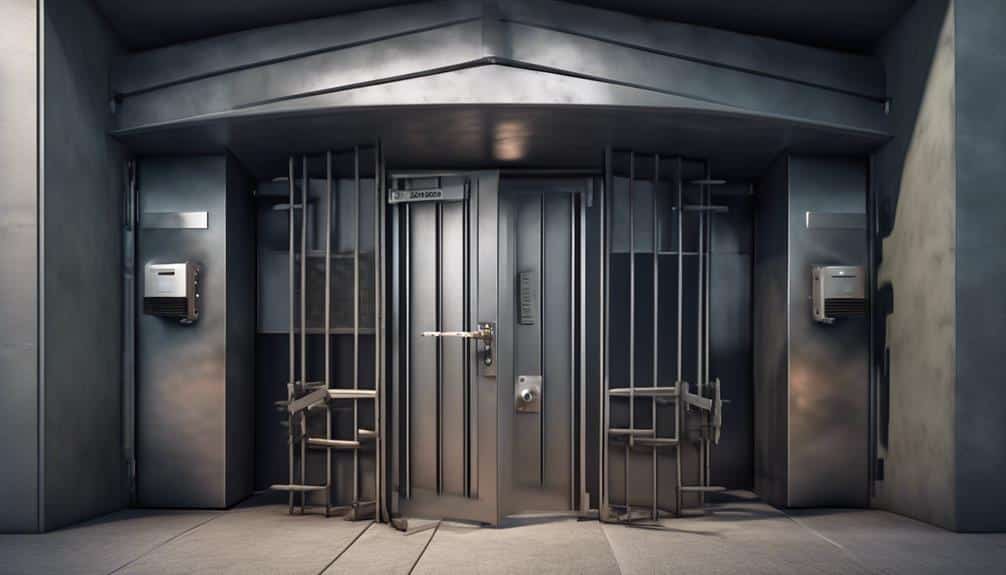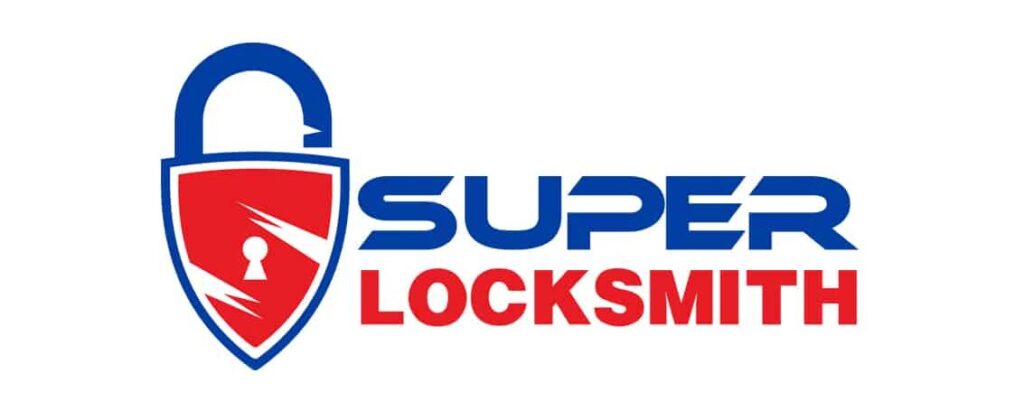Locked doors are the guardians of government buildings, standing tall and strong like stalwart soldiers protecting the nation's secrets. But even the most formidable fortresses can falter, leaving sensitive information and valuable assets vulnerable to breach.
In this uncertain world, where security threats loom large, it is imperative to equip yourself with the knowledge and tools necessary to safeguard these hallowed halls. In this discussion, we will explore eleven essential emergency lockout tips that will fortify your defenses and ensure the safety of your government buildings.
So, are you ready to uncover the secrets to securing these vital institutions?
Importance of Emergency Lockout Services

Emergency lockout services are crucial for ensuring the security and accessibility of government buildings during unforeseen circumstances. The importance of emergency lockout services can't be overstated, as they provide a swift and efficient solution to emergency situations where access to government buildings is needed. When faced with a lockout situation, it's essential to call upon the expertise of professional locksmiths who specialize in emergency lockout services.
One of the key benefits of hiring professional locksmiths for emergency lockout services is their knowledge and experience in dealing with various types of locks and security systems. They possess the necessary skills and tools to quickly and safely gain access to government buildings without causing any damage. Additionally, professional locksmiths undergo rigorous training to stay updated on the latest techniques and technologies in the industry, ensuring that they can handle any lockout situation efficiently.
Another benefit of professional locksmiths is their availability and response time. Emergency lockout situations require immediate action, and professional locksmiths understand the urgency of such situations. They're available round-the-clock, ready to respond to calls and provide prompt assistance. This ensures that government buildings can be accessed quickly, minimizing any potential disruptions or delays.
Assessing Government Building Security
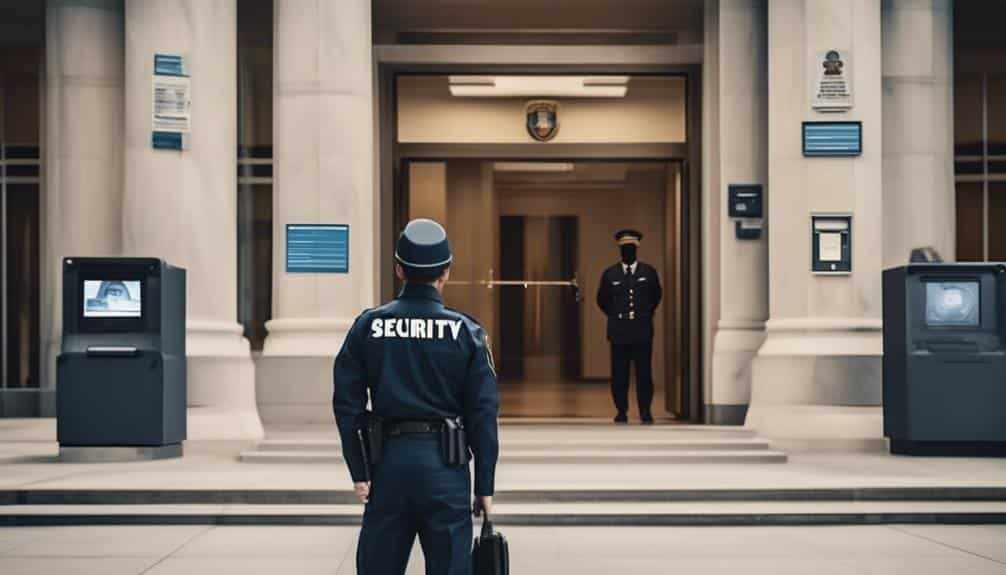
To assess the security of a government building, there are various techniques and methods that can be employed.
Security assessment techniques involve evaluating the physical infrastructure, such as doors, windows, and surveillance systems, to identify any vulnerabilities.
Additionally, vulnerability identification methods can help pinpoint potential weaknesses in access control, cybersecurity measures, and emergency response protocols.
Security Assessment Techniques
Assess the security of government buildings using effective techniques to ensure the safety and protection of all occupants and assets. Conducting a comprehensive security risk assessment is crucial in identifying vulnerabilities and implementing appropriate security measures. Here are some key techniques to consider:
| Assessment Technique | Purpose |
|---|---|
| Physical inspection | Identify potential entry points, weak spots, and areas of concern within the building. |
| Access control review | Evaluate the effectiveness of access control systems, such as key cards or biometric scanners. |
| Intrusion testing | Conduct penetration testing to identify potential security breaches and weaknesses in the building's defenses. |
Vulnerability Identification Methods
One effective method for assessing the security of government buildings is through the identification of vulnerabilities. By employing various vulnerability assessment techniques, security professionals can identify weak points in the building's security system and take steps to strengthen them.
Here are three sub-lists that illustrate different aspects of vulnerability identification methods:
- Physical Vulnerabilities:
- Assessing the integrity of doors, windows, and other access points
- Evaluating the effectiveness of locks, alarms, and surveillance systems
- Identifying potential hiding spots or blind spots that could be exploited by intruders
- Procedural Vulnerabilities:
- Reviewing access control procedures and protocols
- Examining the effectiveness of visitor management systems
- Analyzing emergency response plans and evacuation procedures
- Personnel Vulnerabilities:
- Conducting background checks on employees and contractors
- Training staff on security awareness and protocols
- Implementing strict access control measures for sensitive areas
Identifying Vulnerable Entry Points

Now let's turn our attention to identifying vulnerable entry points in government buildings.
Conducting an entry point assessment is crucial to understanding potential weak spots that could be exploited by intruders.
Entry Point Assessment
Identifying vulnerable entry points is crucial in ensuring the security of government buildings. Conducting an entry point evaluation and analysis allows for a comprehensive understanding of potential weak spots that could be exploited by unauthorized individuals.
Here are three critical aspects to consider during the assessment:
- Physical barriers: Assess the effectiveness of existing doors, windows, and gates. Look for any signs of wear and tear, compromised locks, or outdated security systems.
- Surveillance coverage: Evaluate the placement and functionality of surveillance cameras to ensure they provide adequate coverage of all entry points. Consider blind spots and areas where additional cameras may be necessary.
- Access control systems: Review the efficiency and reliability of access control mechanisms, such as keycard readers or biometric scanners. Identify any vulnerabilities in the system that could potentially compromise security.
Strengthening Weak Spots
To strengthen weak spots in government buildings, it is essential to thoroughly identify and address vulnerable entry points to ensure optimal security measures are in place. By enhancing physical barriers, you can significantly reduce the risk of unauthorized access and potential threats. Here are some key areas to focus on:
| Entry Point | Vulnerability | Recommended Action |
|---|---|---|
| Doors | Weak locks or hinges | Install high-security locks and reinforced hinges. |
| Windows | Fragile glass or weak frames | Replace with shatter-resistant glass and reinforced frames. |
| Walls | Easy to breach or climb | Reinforce walls with barriers like fences or anti-climbing measures. |
| Roof | Accessible entry points | Enhance roof security with motion sensors and sturdy access points. |
Implementing Access Control Measures
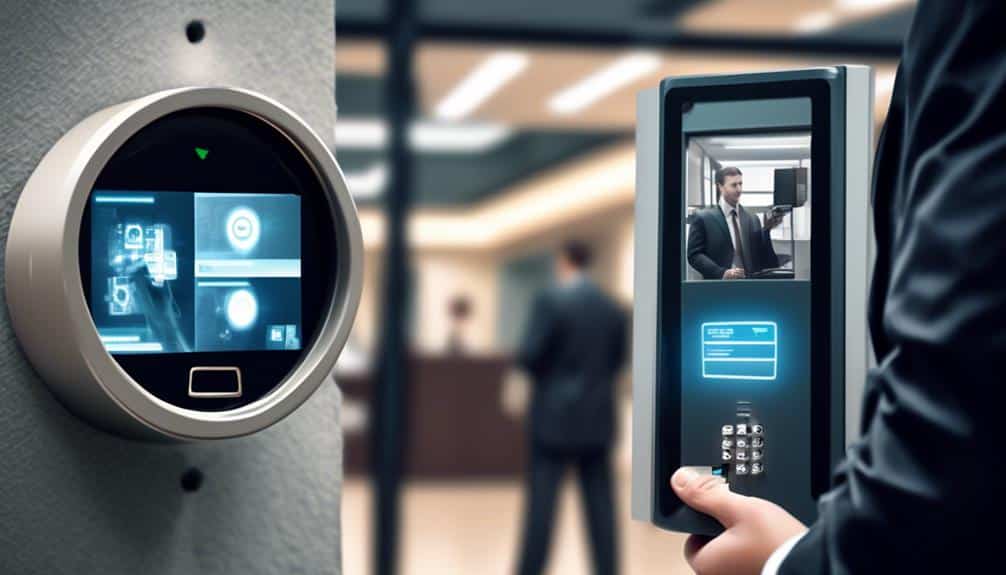
Consider implementing access control measures to enhance security and restrict unauthorized entry into government buildings. By focusing on access control implementation, you can effectively secure entry points and ensure the safety of personnel and sensitive information.
Here are three key measures to consider:
- Card-based Access Systems: Install card readers at entry points to allow authorized personnel to enter using their identification cards. These readers can be integrated with a centralized access control system, providing real-time monitoring and control over who enters the building.
- Biometric Technology: Incorporate biometric authentication methods, such as fingerprint or iris scanners, to further strengthen access control. These systems provide a higher level of security by verifying an individual's unique physical characteristics, reducing the risk of unauthorized entry.
- Visitor Management Systems: Implement a visitor management system that requires all visitors to register and obtain a temporary access pass before entering the building. This helps ensure that only authorized visitors gain access and provides a record of who's in the building at any given time.
Choosing High-Security Locks
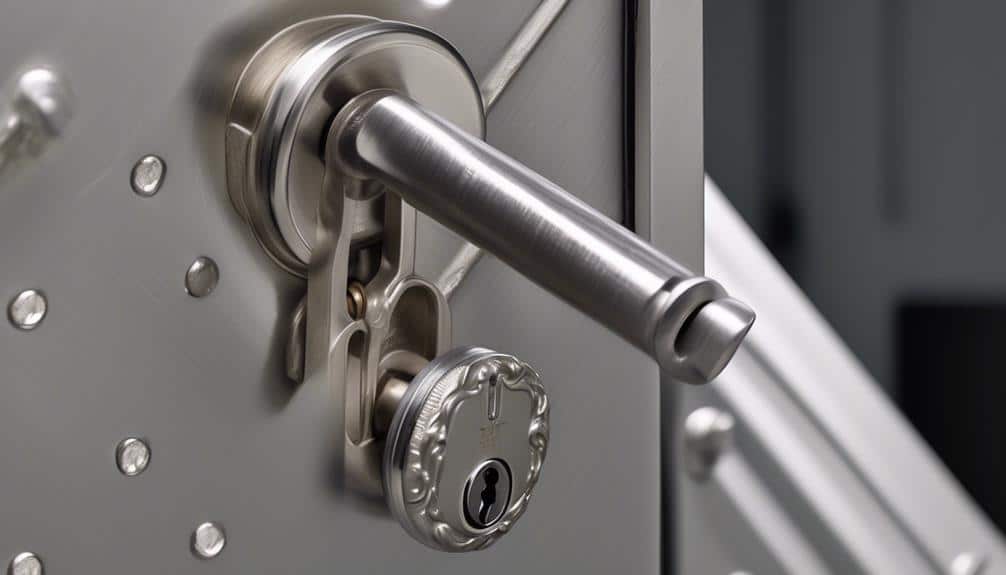
When it comes to securing government buildings, choosing high-security locks is of utmost importance.
Keyless entry systems provide an efficient and convenient way to control access, eliminating the need for physical keys.
Biometric lock technology adds an extra layer of security by utilizing unique biological characteristics to grant access.
Restricted key systems ensure that only authorized personnel can duplicate keys, reducing the risk of unauthorized access.
Keyless Entry Systems
For enhanced security in government buildings, opt for high-security locks that utilize keyless entry systems. Keyless entry systems offer several advantages over traditional key-based locks:
- Convenience: With a keyless entry system, you don't need to carry around a physical key, eliminating the risk of losing it or unauthorized duplication.
- Enhanced Security: Keyless entry systems use advanced encryption technology, making it difficult for unauthorized individuals to gain access.
- Audit Trail: Keyless entry systems can provide a detailed log of who entered the building and at what time, enhancing accountability and security measures.
However, keyless entry systems also have their disadvantages:
- Vulnerability to Hacking: Like any electronic system, keyless entry systems are susceptible to hacking and unauthorized access if not properly secured.
- Power Dependency: Keyless entry systems require power to operate, so in the event of a power outage, alternative access methods must be in place.
- Initial Cost: Keyless entry systems can be more expensive to install compared to traditional lock and key systems, requiring an initial investment.
Despite these drawbacks, keyless entry systems offer significant benefits in terms of convenience, security, and accountability for government buildings.
Biometric Lock Technology
Biometric lock technology revolutionizes high-security locks by utilizing unique physical characteristics for access control. These locks offer numerous benefits when it comes to securing government buildings.
One of the key advantages is the high level of security they provide. Biometric locks use individual identifiers such as fingerprints, iris scans, or facial recognition to grant access, making it nearly impossible for unauthorized individuals to gain entry.
Moreover, these locks eliminate the need for traditional keys or access codes, which can be easily lost, stolen, or duplicated.
However, it's important to acknowledge the limitations of biometric lock technology. For instance, they can be costly to install and maintain. Additionally, some biometric systems may encounter difficulties when dealing with dirty or damaged fingerprints, leading to potential access issues.
Despite these limitations, biometric locks remain an excellent choice for enhancing the security of government buildings.
Restricted Key Systems
To enhance the security of government buildings, consider implementing restricted key systems for high-security locks. Restricted key systems offer an additional layer of protection by ensuring that only authorized personnel have access to specific areas.
Here are three key benefits of implementing restricted key systems:
- Enhanced key control: With a restricted key system, you can maintain strict control over who has access to different areas of the building. This prevents unauthorized duplication of keys and reduces the risk of security breaches.
- Increased security: Restricted keys are designed to be more difficult to pick or replicate, making them highly resistant to tampering or forced entry. This helps to safeguard sensitive information and assets within government buildings.
- Improved accountability: By implementing restricted key management and key control policies, you can track and monitor key usage. This enables you to identify any potential security breaches and hold individuals accountable for their actions.
Installing Surveillance Systems
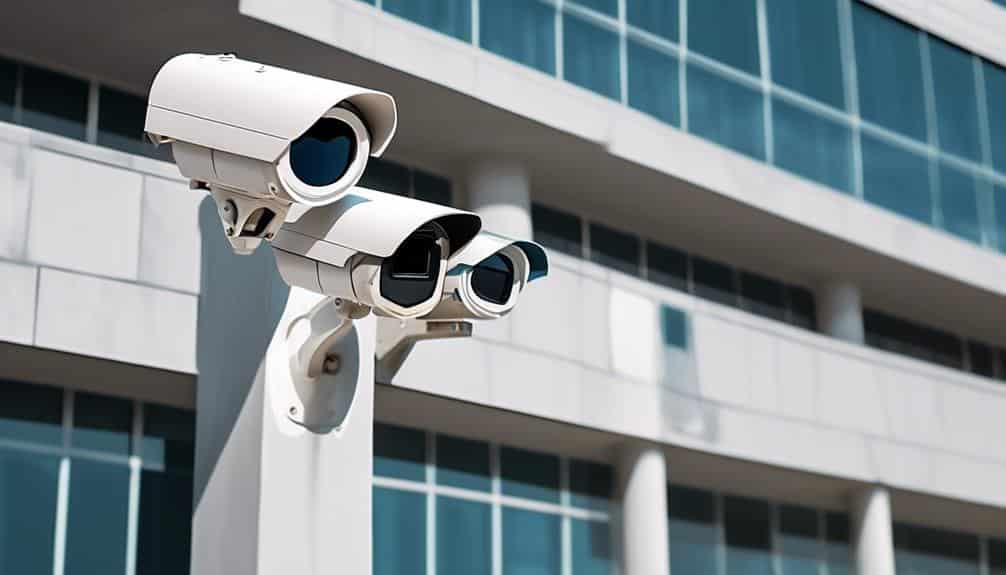
Consider incorporating a reliable surveillance system to enhance security measures within government buildings. Surveillance system integration plays a crucial role in safeguarding government facilities and protecting sensitive information. By strategically placing security cameras, you can effectively monitor and deter potential threats, ensuring the safety of both personnel and valuable assets.
When considering security camera placement, it's essential to identify key areas that require constant monitoring. Entrances, exits, parking lots, and high-security zones should be prioritized. Additionally, consider installing cameras in areas prone to unauthorized access, such as server rooms or restricted archives. By capturing detailed footage in these critical locations, you can detect and investigate any suspicious activities promptly.
To maximize the effectiveness of surveillance systems, ensure proper integration with other security measures. Integration allows for seamless coordination between access control systems, alarms, and surveillance cameras, creating a comprehensive security network. This integration enables real-time monitoring, immediate response to security breaches, and the ability to gather valuable evidence during investigations.
Furthermore, investing in advanced features such as facial recognition technology and motion detection can enhance the efficiency of your surveillance system. These features allow for accurate identification of individuals and prompt alerts for any unexpected movements or disturbances.
Training Staff on Emergency Lockout Procedures

Train your staff on emergency lockout procedures to ensure swift and effective response in critical situations. Proper training is essential to maximize the effectiveness of your emergency procedures.
Here are three key reasons why training is crucial:
- Familiarity with Lockout Procedures: By training your staff on emergency lockout procedures, you ensure that they're well-versed in the necessary steps to take during an emergency. This includes knowledge of evacuation routes, securing entry points, and properly communicating with emergency services.
- Confidence and Preparedness: Through training, your staff will gain the confidence and preparedness required to handle emergency situations effectively. They'll be equipped with the skills and knowledge necessary to act swiftly and make informed decisions, minimizing potential risks and ensuring the safety of everyone involved.
- Collaboration and Teamwork: Training your staff on emergency lockout procedures fosters a culture of collaboration and teamwork. By practicing these procedures together, your staff will develop a shared understanding of their roles and responsibilities during an emergency. This promotes effective communication and coordination, enabling a more efficient response.
Establishing Emergency Response Protocols
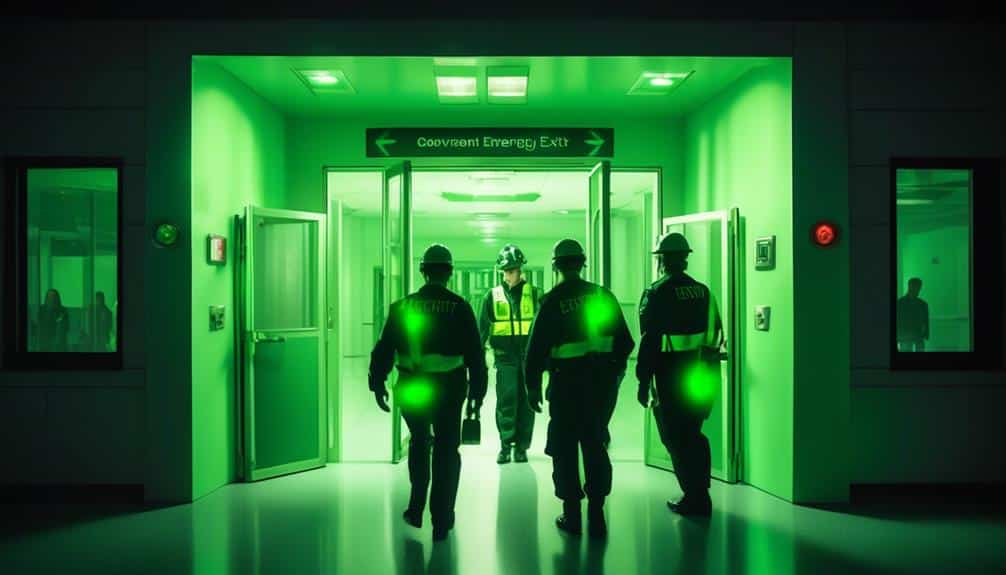
Establish a comprehensive set of emergency response protocols to ensure a swift and coordinated reaction to critical situations in government buildings. Establishing emergency response procedures is crucial for safeguarding the safety and security of government personnel and the public they serve. These protocols should outline the necessary steps to be taken when faced with emergencies such as natural disasters, terrorist attacks, or other threats.
To begin, conduct a thorough risk assessment of the government building to identify potential vulnerabilities and develop specific emergency response plans accordingly. This assessment should take into account the building's layout, occupancy, and potential hazards. Once the risks are identified, establish clear guidelines on how to respond to each type of emergency. This includes protocols for evacuations, sheltering in place, lockdowns, and communication procedures.
Ensure that all government staff receive comprehensive emergency lockout training. This training should cover the protocols, procedures, and best practices for responding to emergencies. It's essential that staff members understand their roles and responsibilities during an emergency, as well as how to effectively communicate and coordinate with emergency responders.
Regularly review and update the emergency response protocols to ensure their effectiveness. Conduct drills and exercises to test the response capabilities of staff and identify areas for improvement. By establishing and regularly refining emergency response protocols, government buildings can be better prepared to handle critical situations and ensure the safety of everyone inside.
Utilizing Biometric Authentication Systems
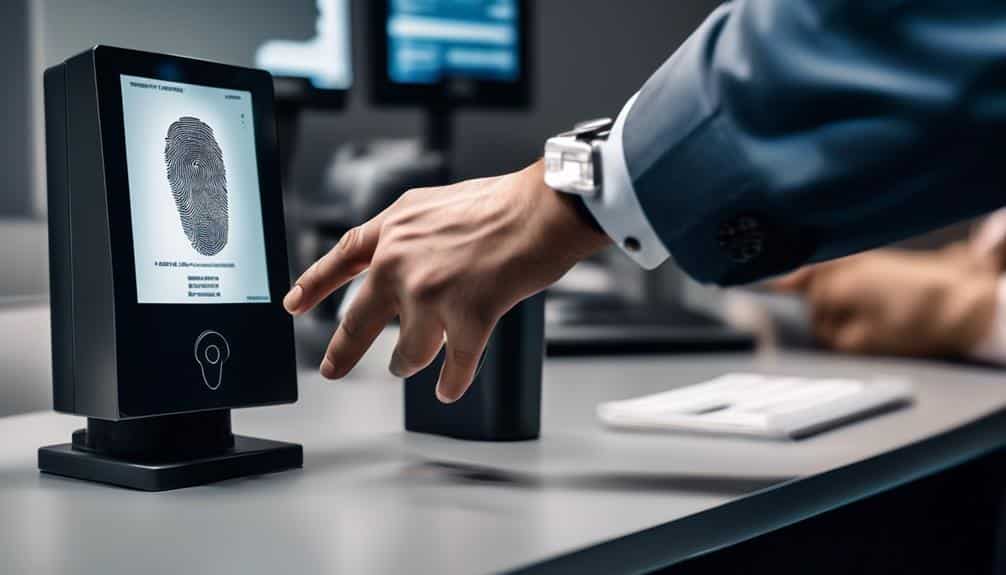
To enhance the security measures in government buildings and further safeguard personnel and the public, implementing biometric authentication systems is a prudent step forward. These advanced systems offer several benefits that traditional security methods can't match.
When implementing biometric security, consider the following:
- Enhanced Identification Accuracy: Biometric authentication systems use unique physical or behavioral characteristics, such as fingerprints, facial features, or iris patterns, to verify an individual's identity. This ensures a higher level of accuracy compared to traditional identification methods like ID cards or passwords.
- Increased Security Measures: Biometric authentication provides an additional layer of security by eliminating the possibility of stolen or forged access credentials. This significantly reduces the risk of unauthorized access to sensitive government areas.
- Streamlined Access Control: Biometric systems facilitate seamless and efficient access control processes. Instead of relying on physical keys or access cards, individuals can simply authenticate their identities through biometric scans, allowing for quick and convenient entry.
Implementing Remote Locking Mechanisms
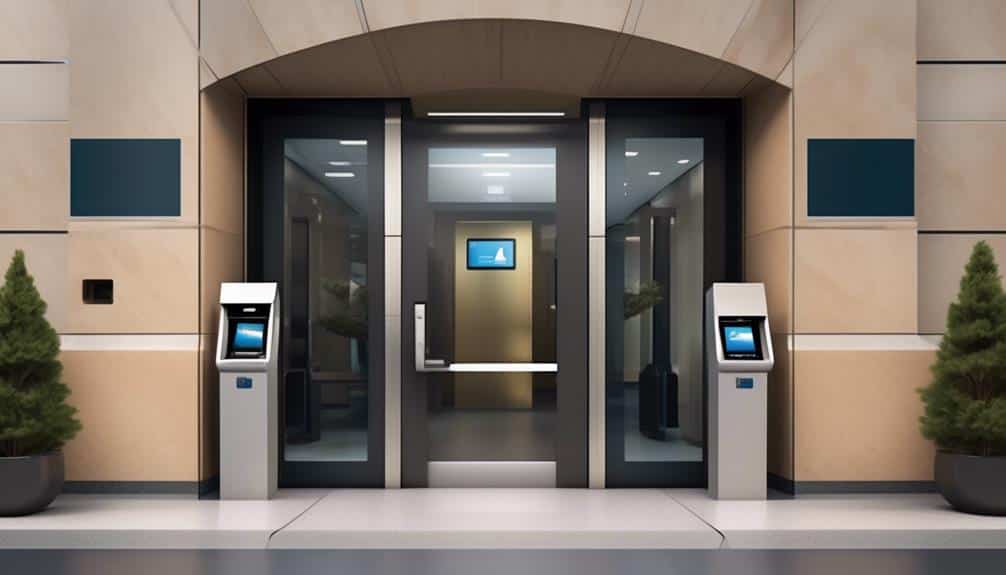
Consider implementing remote locking mechanisms to enhance the security of government buildings and provide efficient control over access. Remote locking technology allows you to remotely control and monitor the locking and unlocking of doors, giving you greater flexibility and convenience in managing building security. With remote access control, you can grant or revoke access permissions to individuals or groups remotely, reducing the risk of unauthorized entry and enhancing overall building security.
Remote locking mechanisms offer several advantages for government buildings. Firstly, they provide an added layer of security by allowing you to lock or unlock doors from a central control station, eliminating the need for physical keys and reducing the risk of lost or stolen keys. This ensures that only authorized personnel can access the building, minimizing the potential for security breaches.
Secondly, remote locking mechanisms enable real-time monitoring of access, giving you detailed information on who enters and exits the building, and at what times. This data can be invaluable in investigations or audits, enabling you to track and analyze access patterns and identify any suspicious activities.
Lastly, remote locking mechanisms offer convenience and efficiency in managing access control. With the ability to remotely grant or revoke access permissions, you can easily respond to changing security needs or emergencies, without the need for physical presence at each door. This saves time and resources, allowing you to allocate personnel to other critical tasks.
Conducting Regular Security Audits
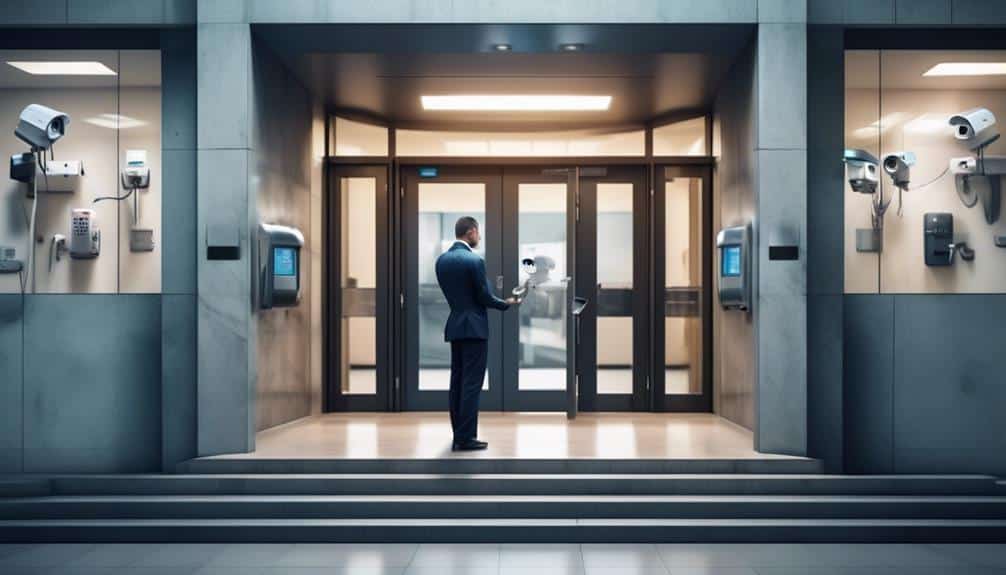
To ensure the ongoing effectiveness of your government building's security measures, regular security audits are essential. These audits provide a comprehensive evaluation of your current security protocols and help identify any vulnerabilities that may exist.
Here are some reasons why conducting regular security audits is crucial:
- Identify Weak Points: Regular security audits allow you to identify weak points in your government building's security system. This could include outdated technology, malfunctioning locks, or areas of the building that aren't adequately monitored.
- Evaluate Emergency Preparedness: Security audits also help evaluate your government building's emergency preparedness. By testing emergency lockout services and response times, you can ensure that your building is well-equipped to handle any potential threats or emergencies.
- Stay Updated with Regulations: Government regulations and security standards are constantly evolving. Regular security audits help you stay up to date with the latest regulations and ensure that your building remains compliant with all necessary security measures.
Frequently Asked Questions
What Are the Common Types of High-Security Locks Used in Government Buildings?
When it comes to securing government buildings, high-security locks are crucial. There are several common types of these locks that are commonly used.
One popular option is keyless entry systems, which offer enhanced security and convenience. These advanced lock systems play a vital role in ensuring the safety and protection of government buildings.
Electronic locks are another common choice, providing benefits such as keyless access, audit trails, and remote monitoring capabilities. These advanced lock systems play a vital role in ensuring the safety and protection of government buildings.
How Often Should Government Buildings Conduct Security Audits?
To ensure the safety of government buildings, it's crucial to conduct regular security audits. These audits help identify vulnerabilities and weaknesses in the building's security system.
Are There Any Specific Regulations or Standards That Government Buildings Need to Adhere to in Terms of Their Lockout Procedures?
Government buildings must adhere to specific lockout regulations and standards. These guidelines ensure the security and safety of the premises. It's essential to have effective lockout procedures in place to prevent unauthorized access and protect sensitive information.
These regulations may vary depending on the country or region, but generally include measures such as using high-security locks, implementing access control systems, and conducting regular lockout drills. Adhering to these standards is crucial for maintaining the integrity of government buildings and the protection of its occupants.
Can You Provide Examples of Biometric Authentication Systems That Are Commonly Used in Government Buildings?
Biometric authentication systems are commonly used in government buildings to enhance security. These systems utilize unique physical or behavioral characteristics, such as fingerprints or iris scans, to verify a person's identity. By implementing biometric authentication, government buildings can ensure that only authorized individuals have access to sensitive areas.
This technology provides a high level of security and helps prevent unauthorized entry or breaches. Implementing biometric authentication systems is an effective way to enhance government building security.
What Are Some Best Practices for Training Staff on Emergency Lockout Procedures in Government Buildings?
When it comes to training staff on emergency lockout procedures in government buildings, there are some best practices you should consider.
First, use training techniques that engage your staff, like hands-on simulations and scenario-based exercises. This will ensure they understand the procedures thoroughly.
Additionally, make sure to provide regular refresher training sessions to keep their skills sharp.

